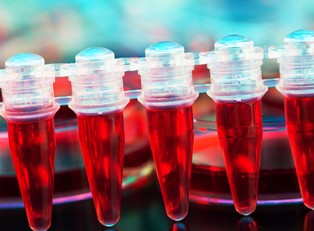Cord blood is blood contained in the placenta and umbilical cord. These cord blood stem cells are rich in cellular ingredients that nourish the immune system and the blood system. When cord blood cells are transplanted into a patient, they help to restore the blood and immune systems to help replace diseased blood and fight diseases. Cord blood is collected after the umbilical cord is severed from the newborn during birth. It is then stored cryogenically in a blood bank for use in the future.
Cord blood is collected from the placenta and umbilical cord immediately after a baby’s birth. It contains stem cells rich in cellular ingredients with the rare ability to turn into almost any type of cell. When stem cells are transplanted into a patient, they can be used as treatments for dozens of diseases. Cord blood is stored cryogenically and is used both in current treatments and in research to develop new treatments.
Cord Blood Banking
Parents must decide to store cord blood by the 34th week of gestation. Not for medical reasons, but simply because most cord blood banks and labs are lamentably understaffed. At birth, the cord blood is harvested in a procedure that is safe and painless for both mother and child, then shipped off to the chosen bank.
Private banks can be a pricey option, but they ensure the cord blood remains safe if the baby develops a disease stem cells can help treat, such as sickle cell anemia or leukemia. These cells are generally a match for siblings, as well. Public cord blood banks are free, but the sample is not reserved for the child it came from. Instead, these organizations use cord blood to treat other families or for research into new stem cell treatments.
Why Cord Blood?
Cord blood stem cells are actually different from other stem cells. In particular, cord blood cells can be blood-forming, or “hematopoietic” stem cell (HSC). Cord blood cells have a very special trait that makes them unique: contrary to adult stem cells, they do not have to be an exact match to be an effective means of treatment. However, it can be hard to collect enough to provide an adult with treatment.
Additionally, the cord tissue stem cells that come from the umbilical cord and placenta are mesenchymal stem cells (MSC). MSC are among the most popular type of stem cells used in research, particularly for immune diseases and muscle or bone issues. Cord tissue MSC not only grows significantly faster than adult MSC, most samples have never been exposed to the diseases adult cells have. Thus, the stem cells that come from cord blood and tissue make optimal cells for both treatment and research.
Diseases Treated by Cord Blood
When cord blood treatment was first used 25 years ago, it was used only for leukemia. Today, cord blood is used in the treatment of more than 80 diseases. This includes genetic diseases, blood disorders, degenerative diseases, some cancers, and autoimmune disorders.
Cord blood stem cells can be used to stimulate the growth of new blood cells and bone marrow after chemotherapy and radiation treatments; treat certain kinds of anemia and issues with blood clotting; and immune conditions in which the immune system lacks certain types of blood cells. Recent years have seen cord blood stem cell treatments for traumatic brain injuries in infants, and even treatments for Alzheimer's and Parkinson’s diseases. Research suggests even certain metabolic disorders and spinal cord injuries may have met their match with cord blood treatments.
Although controversial, ongoing worldwide research continues to find new uses for cord blood, and exciting discoveries are being made all the time. According to ViaCord from PerkinElder, cord blood is currently used in the treatment of or research for the following diseases, disorders, and injuries:
Cancers
- Acute lymphoblastic leukemia (ALL)
- Acute myeloid leukemia (AML)
- Burkitt's lymphoma
- Chronic myeloid leukemia (CML)
- Juvenile myelomonocytic leukemia (JMML)
- Non-Hodgkin's lymphoma
- Hodgkin's lymphoma
- Lymphomatoid granulomatosis
- Myelodysplastic syndrome (MDS)
- Chronic myelomonocytic leukemia (CMML)
Bone Marrow Failure Syndromes
- Amegakaryocytic thrombocytopenia
- Autoimmune neutropenia (severe)
- Congenital dyserythropoietic anemia
- Cyclic neutropenia
- Diamond-Blackfan anemia
- Evan's syndrome
- Fanconi anemia
- Glanzmann's disease
- Juvenile dermatomyositis
- Kostmann's syndrome
- Red cell aplasia
- Shwachman syndrome
- Severe aplastic anemia
- Congenital sideroblastic anemia
- Thrombocytopenia with absent radius (TAR syndrome)
- Dyskeratosis congenita
Blood Disorders
- Sickle-cell anemia (hemoglobin SS)
- HbSC disease
- Sickle ßo Thalassemia
- a-thalassemia major (hydrops fetalis)
- ß-thalassemia major (Cooley's anemia)
- ß-thalassemia intermedia
- E-ßo thalassemia
- E-ß+ thalassemia
Metabolic Disorders
- Adrenoleukodystrophy Gaucher's disease (infantile)
- Metachromatic leukodystrophy
- Krabbe disease (globoid cell leukodystrophy)
- Gunther disease
- Hermansky-Pudlak syndrome
- Hurler syndrome
- Hurler-Scheie syndrome
- Hunter syndrome
- Sanfilippo syndrome
- Maroteaux-Lamy syndrome
- Mucolipidosis Type II, III
- Alpha mannosidosis
- Niemann Pick Syndrome, type A and B
- Sandhoff Syndrome
- Tay-Sachs Disease
- Lesch-Nyhan disease
Immunodeficiencies
- Ataxia telangiectasia
- Chronic granulomatous disease
- DiGeorge syndrome
- IKK gamma deficiency
- Immune dysregulation polyendocrineopathy
- X-linked Mucolipidosis, Type II
- Myelokathexis X-linked immunodeficiency
- Severe combined immunodeficiency
- Adenosine deaminase deficiency
- Wiskott-Aldrich syndrome
- X-linked agammaglobulinemia
- X-linked lymphoproliferative disease
- Omenn's syndrome
- Reticular dysplasia
- Thymic dysplasia
- Leukocyte adhesion deficiency
Other
- Osteopetrosis
- Langerhans cell histiocytosis
- Hemophagocytic lymphohistiocytosis




